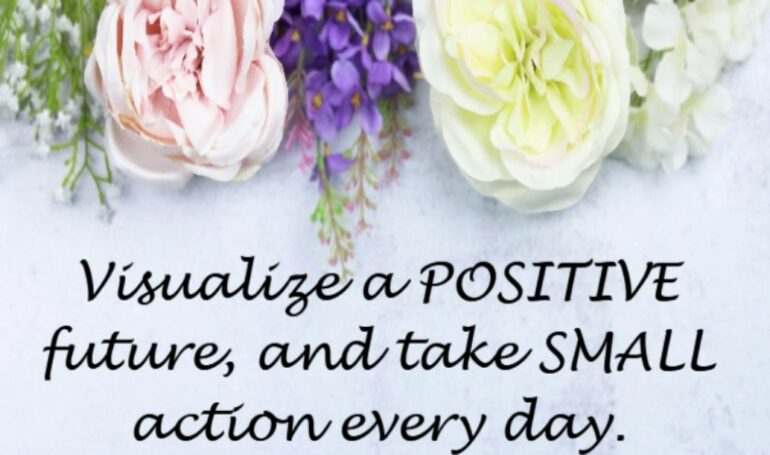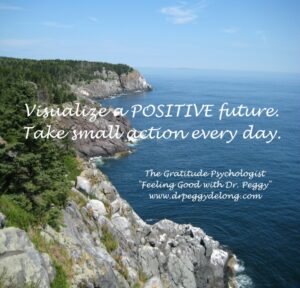
Visualize and Take Small Action
In my part of the country, we’re “opening up”, but things are far from “normal”. So much loss. Loss of loved ones. Job loss. Loss of graduation ceremonies, celebrations, family trips, and so much more.
COVID19 has affected people in many different ways. Probably as many different ways as there are people. One commonality for many is the loss of structure. The loss of routine. The loss of a schedule. The loss of our fundamental daily rhythm and cycle of life. This can feel quite unsettling and disorienting.
This, intermixed with the loss of touch, the loss of in-person contact, the loss of seeing smiles as they’re covered by masks – all of this results in a sort of collective mass trauma. This can make us feel disconnected from ourselves, disconnected from others, and even disconnected from reality at times. People are feeling lonely, confused, distractible, and empty.
If you are feeling this way, I want to let you know that you ARE NOT ALONE. 78% of Americans report that COVID19 is a significant source of stress, and Americans are reporting that they are more unhappy than they’ve been in 50 years.
It is helpful to stop looking outward at all of the unpredictability, unknown, and chaos, and instead look inward. Reflect. Grow. Or simply BE.
One simple suggestion regarding looking inward to cope is to use your mind and develop a positive view of the future. Remember that difficult days will pass, and visualize a positive future. Visualize your positive future in as much detail as possible. I talk about this in my upcoming book in the chapter – “Know That The Toughest Days Will Pass.” When I wrote this chapter two years ago, I never imagined how it would be applicable to COVID19. I never imagined COVID19.
One concrete way to develop a positive view of the future is a method called goal visualization. This involves picking a manageable, doable goal, and then writing down how you are going to accomplish that goal. Then you can spend time working on that goal every day. It need not be long. It can be as little as 10 minutes a day. Or it can be one simple, but powerful behavioral change.
Here is a personal example of how I used one small behavioral change to better achieve my goals. When schools closed for my 3 teens and my teacher husband, and my physical office closed, I was able to sleep in. This is a luxury I never have! I was able to go to bed without setting an alarm. At first, this was absolutely wonderful. I could not remember the last time I did not need to set an alarm because I always had to be somewhere, and often earlier on weekends than during the week.
So this was pure luxury, and pure bliss – for about a week.
Then as the pandemic continued, I found myself sleeping later and later. I still did not set an alarm, and I knew that I would always wake up before my first video session with a client.
Then it began to feel yucky. The lack of schedule threw me off. I was waking up leisurely, drinking coffee like I had all the time in the world, and then wondering why I was not getting anything done. I looked in my paper calendar, and almost everything I had on my calendar was canceled in those first few weeks. I’m old-fashioned and still use a paper daily planner with calendar, so I can visualize my schedule on one large page.
This visual image was tough to look at.
In-person Gratitude presentations – canceled
Committee meetings – canceled
Business meetings – canceled
My son’s Eastern ski championship in New Hampshire – canceled
Taking my mom out to lunch for her birthday – canceled
Book signings – canceled
Book club discussions – canceled
Returning to my home town for a speaking engagement to benefit pediatric cancer – canceled
Teaching how to make mental health/inspirational bracelets at a library – canceled
This lack of structure and schedule was disorienting. The coveted luxury of sleeping in soon became disorienting.
I thought about how I want to feel in the future looking back at this time, and it was certainly not the unproductive, lazy, confused way I was feeling. So I visualized what I wanted. I visualized a more optimistic future. I visualized being productive and accomplishing my goals, including seeing my next book in print. “Feeling Good: 36 Ways to Happiness, Even During Tough Times.”
When we maintain a positive view of our future, we are happier, and it becomes easier to get through a difficult time. This can involve identifying one goal, and the first step to achieving that goal. Achieving those small steps is one way that helps us feel good about ourselves. These successful attempts make us feel accomplished. Doing so has been demonstrated to decrease depression and increase happiness.
When we visualize a more positive, pleasant future, we become more motivated to take steps to achieve that, and more optimistic about our ability to do so.
For many people, we need to simplify our ideas about how we view success and not expect too much of ourselves, and others, during this time.
We need to develop hope and view our daily lives through that perspective, that lens.
Visualize your small, achievable goal, and the simple, actionable steps to get there. Write those steps down. Then dedicate time every day toward that goal.
This could be cleaning the bathroom. Removing clutter from the kitchen. Washing windows. Washing your car. Organizing digital videos and photos. Organizing and preserving printed photos. Outlining your book. Washing all the sheets in the house. Pulling weeds. Writing a blog or guest blog for someone. Going through your closet and donating what you no longer wear. Trying a new recipe. Reading a chapter in a book. The possibilities are endless.
For me, I visualized my goal of being more productive during my new work day. Implementing this began with a simple behavior change of setting my alarm to get up an hour earlier.
That is all I did. I simply set my alarm clock to get up an hour earlier than when I was sleeping in. That simple behavior change has done wonders for my psyche, my circadian rhythm, and my productivity.
What is it for you? How do you view your more optimistic future? What small goal can you visualize? What steps can you take to get there?
In Gratitude,
Peggy
The Gratitude Psychologist
“Feeling Good with Dr. Peggy” – a monthly membership for cultivating resilience, joy, gratitude, love, and meaning


Leave a Reply